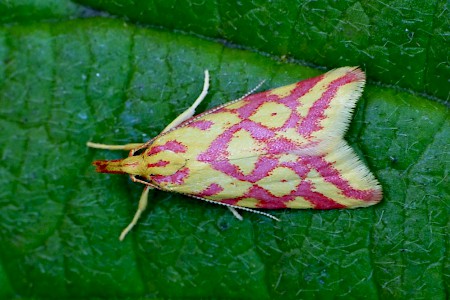32.051 BF657
Hypercallia citrinalis
(Scopoli, 1763)
Wingspan c.19 mm.
This attractive and highly distinct species has a very disjunct distribution in the British Isles, being found in the extreme west: The Burren, County Clare (Bradley, 1953) and in south-east England on the North Downs, Kent. Until 1979, the moth was found at another site on the North Downs, however, mainly due to scrub encroachment onto open downland, the insect was becoming very scarce and after 1979 no further individuals were recorded, and the species was feared to be extinct in England. In 2019 H. citrinalis was re-discovered in Kent (Hunter, 2019). This was also on the North Downs further west than the original site but one known to mid-20th century and earlier entomologists as a site for this insect (Morris, 1958 Huggins, 1958, b, Wakely, 1958). There are also old records from Essex and Co. Durham dating back to the 19th century.
The moths fly in June and July around their favoured habitat of dry, chalky grassland. Although the Polygala spp. foodplant is spread widely across the downland where the insect occurs in Kent, citrinalis is quite local and inhabits sheltered localities close to bushes. The accepted foodplants are either P. vulgaris (common milkwort) or P. calcarea (chalk milkwort; the larvae feeding in a slight spinning in the flowers. However, a search for larvae in 2024 found it only on Polygala vulgaris. The pupa hangs openly head down from a silken pad on the foodplant or adjacent vegetation and is bright apple green.
------
Species account kindly provided by Philip Jewess.

 UKMoths
UKMoths 




